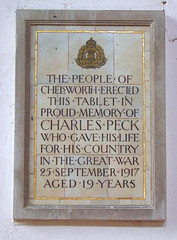| |
 |
|
There
is no other church in Suffolk quite like All
Saints. Chelsworth is one of the prettiest
villages in Suffolk, and its church is only
approachable through someone's garden, as at
Cookley. This forces you to say hello to the
person putting out their washing, or strimming
their borders. I think this is lovely. The church
is no match for the village, I fear, being
cement-rendered and Victorianised inside.But it
is bold, and majestic, and seen across the fields
has a beauty of its own that none can match.
Chelsworth
is the thinking-person's Prettiest Suffolk
Village - much classier than blowsy Kersey. That said, as a cyclist I
prefer Kersey. Chelsworth's village street is a
ratrun for those taking the shortcut through Bildeston between Stowmarket and
Sudbury, and is no pleasure to wander along
anymore.
I try
to make it a habit to walk around a church before
going inside. This sounds easy, but so often I am
tempted to rush and see if the church is open,
and end up going inside first. All Saints repays
the effort of resisting this more than most; if I
tell you that I have never found it locked, and
even if it is you can pop back to the house and
ask them to open it, perhaps you will also walk
around it first. You will find, with some
surprise I hope, that the hidden south side is
even grander than the north, and that the amazing
beturreted south porch is no longer in use, but
has become a vestry. In its windows is reset 17th
Century continental glass, but these are locked
away from public sight. This side is a familiar
Perpendicular rebuilding of the late 15th
century; it reminds us that we are in Suffolk. As
a bonus, several of the buttresses still bear consecration crosses.
|
We now go
into All Saints from the north, and this porch has been
Victorianised in the nicest possible way. This
description holds true for the whole church, really;
there is an enthusiasm about Chelsworth which is tenuous
elsewhere. It is all done very tastefully, except for one
awful, dreadful mistake, which we will come to in a
moment.
Before going
in, you will have wondered at the extraordinary structure
set into the wall of the north aisle. Inside, this turns
out to be a huge 14th century tomb canopy. Mortlock argues that it was originally free-standing
before being sited here, presumably in one of the
arcades, but possibly up in the chancel, in which case it
might once have been an Easter
sepulchre. The
case is made for it being the tomb of Sir John Philibert,
who died in 1334. It is a magnificent piece.
The windows
are almost entirely glazed in 19th century glass of an
understated kind; although this is a big church, it
doesn't feel the least bit urban. You never doubt that
you are in a rural outback, so presumably Diocesan
architect Richard Phipson didn't get his hands on it. The
millennium window by Paul Quail at the west end of the
north aisle is barely noticeable, which is probably the
best thing that can be said about it.
| Above the chancel
arch, there is a doom painting. These are rare
enough survivals, given that most churches must
have had them. Unfortunately, the people who
found it in the 19th century thought it was so
significant that they repainted it. Now,
it sits up there in garish colours as a testimony
to Victorian ignorance; which is a shame,
considering the good things they did elsewhere
here. The rainbow in particular, on which Christ
sits, looks as if it has been done for a
children's party in the 1970s. A
significant family in these parts in years gone
by was the Pocklingtons. They have a hatchment,
and several memorials, but the most interesting
is probably to Sir Robert Pocklington, who died
in 1840. He was a knight of the military order of
Maria Theresa, created as such in the late 18th
century by Francis II, the last emperor of the
Holy Roman Empire. Legend has it that Pocklington
saved the emperor in person from the attentions
of the French. I wonder what they made of that in
this rural outback?
Another
name worthy of mention is Charles Peck.
Incredibly and mercifully, this village of more
than 300 people lost only one of its sons to the
horror of the First World War. He was 19 when he
died in September 1917, a teenage innocent on the
killing fields of Flanders. Because of this, he
gets the pretty little war memorial all to
himself. Across the church, a memorial to John
Venables Scudamore, killed at Gallipoli, reminds
us that he too was born in this parish.
|
|
 |
Simon
Knott May 2003, updated July 2015
|
|

